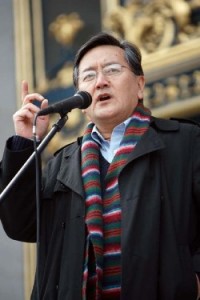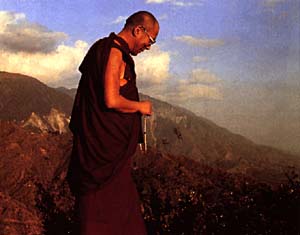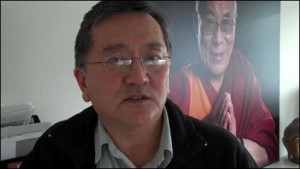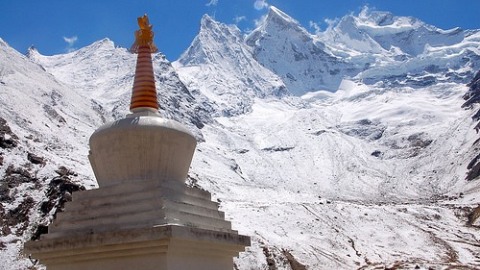Tenzin Tethong is currently a Distinguished Fellow at the Tibetan Studies Institute at Stanford, and President and one of the founding members of the Dalai Lama Foundation, as well as Board Chair of the Committee of 100 for Tibet. In the 1970’s, he worked with members of Congress to secure the first visit of the Dalai Lama to the United States.
 A former Representative of H.H. the Dalai Lama in New York and Washington, Tenzin Tethong was instrumental in initiating many key Tibetan organizations in the United States. He has also been Prime Minister of the Central Tibetan Administration.
A former Representative of H.H. the Dalai Lama in New York and Washington, Tenzin Tethong was instrumental in initiating many key Tibetan organizations in the United States. He has also been Prime Minister of the Central Tibetan Administration.
As the website of the Tibetan Community at Dharamsala says, “Over 80,000 Tibetans led by their religious and temporal leader, His Holiness the Dalai Lama, have fled the Chinese occupation of their country and established a refugee community at Dharamsala in India. Facing the destruction of their culture and religion (of the country’s 6,259 monasteries, nunneries and temples, all but eight have been completely destroyed), they had a duty which far transcended the need merely to keep body and soul together: a duty to nurture a whole civilization in exile.”
Tenzin Tethong and I talked at length on skype about his storied career, wide-ranging experiences and overlapping perspectives. We also explored the challenge and example Tibet poses and presents for the world. The following excerpts from our dialogue provide some background and history.
Martin LeFevre: Other than at Dharamsala, where the government in exile is located, I know there are Tibetan communities in America and Europe. Do you call it a diaspora?
Tenzin Tethong: There are scattered communities in the United States and Canada, and to a lesser extent in Europe—for example, there’s been a Tibetan community in Switzerland since the early 1960’s. A few thousand Tibetans have come to the United States and Canada the last 15 years, so the description of a diaspora is becoming a little more common.
ML: Were you born in Tibet, and when did you leave?
Tenzin: I was born in Tibet, in 1948. My parents left when I was about six, so we managed to come out before 1959 [when the Dalai Lama went into exile].
ML: Tell me a little about your childhood and early life.
Tenzin: I went to school in Darjeeling at a missionary school, and attended some of the first refugee schools in India. My father was a teacher in one of the schools.
Soon after my high school graduation, I started to work in Dharamsala as an interpreter, secretary and translator. From  1967 onwards, I became involved in many of the Tibetan activities, especially among the young people at that time. I worked on publications and to self-organize the youth, such as the Tibetan Youth Congress, and a few years later I was sent to New York in 1973, where there had been a Tibetan appeal at the United Nations.
1967 onwards, I became involved in many of the Tibetan activities, especially among the young people at that time. I worked on publications and to self-organize the youth, such as the Tibetan Youth Congress, and a few years later I was sent to New York in 1973, where there had been a Tibetan appeal at the United Nations.
ML: What was the nature of that appeal?
Tenzin: It began in 1959 at the UN General Assembly, with resolutions also in 1961 and 1965 on Tibet, essentially calling on China to respect the human rights of the Tibetan people, and in one resolution saying that the right of self-determination of the Tibetan people should be respected.
ML: So you first came to the United States just after Nixon’s rapprochement with China?
Tenzin: Yes, I came at a time when the Office of Tibet, which was representing His Holiness the Dalai Lama and the Tibetan government, was being shut down. The US government had changed its policies on China [under Nixon], and we were being encouraged to close down our activities. From that point on, official support, and shall we say unofficial support was not at all forthcoming [laughs dryly].
ML: You don’t sound bitter though.
Tenzin: People in America knew very little about Tibet at the time. But we were not forced to shut down, to the credit of the United States. The office continued, and I was there for the first few years, just one person, trying to figure out the United States, Tibet work, and myself as well—I was only in my mid-20’s.
ML: What kind of work did you do at that time?
 Tenzin: I was in touch with just a handful of Americans who had interest in Tibet, some with scholarly backgrounds, others who had visited India and Nepal, among them young travelers, hippies [smiles]. Some had found Tibetans to be very friendly, helpful and kind. You could say we were a whole rag-tag bunch.
Tenzin: I was in touch with just a handful of Americans who had interest in Tibet, some with scholarly backgrounds, others who had visited India and Nepal, among them young travelers, hippies [smiles]. Some had found Tibetans to be very friendly, helpful and kind. You could say we were a whole rag-tag bunch.
ML: What was your goal?
Tenzin: Working with that small group, and a handful of Tibetan Buddhists and Buddhist scholars scattered across the United States—there were only 2-300 Tibetans in the country at that time—gradually we built up a small circle of friends and network of friends. The issue of inviting His Holiness to the United States came up often.
ML: Politically, that must have been a delicate situation.
Tenzin: In the early ‘60’s there may have been some interest by the US government in a possible visit by His Holiness, but by the mid-70’s of course nobody wanted anything that would upset the Chinese. So I got involved in trying to plan a visit by His Holiness, and began to work with this new circle of friends. It became a fairly complicated and difficult attempt, but finally we did manage to organize something for His Holiness, and so in the fall of 1979 he came to the United States.
ML: Do you consider that first visit successful?
Tenzin: There were many difficulties, but the visit became successful because of His Holiness’ ability to reach out, speak, and be able to communicate with a lot of people in different situations.
ML: With whom did the Dalai Lama meet on that first visit?
Tenzin: Many of the visits were to give a talk or lecture at a university, and others were at Buddhist centers, or inter-church ceremonies.
ML: There was a lot of sympathy for the plight of the Tibetan people at that time as I recall, and a growing respect and affection for the Dalai Lama.
Tenzin: Yes, that first visit led us to establish a new foundation in America, and it extended to the United States Congress. The White House and the State Department obviously didn’t want much to do with Tibet or the Dalai Lama really, because the US policy was now completely to build a relationship with China.
ML: How little things have changed, and how much. What kinds of problems did you run into?
Tenzin: When we were first planning the visit we had difficulty in getting some sense of, shall we say, if not approval, at least non-objection from the US government. We didn’t want His Holiness to be stopped at the airport and denied a visa. So we worked with one or two congressman, and got enough informal support on Capitol Hill to prevent anyone from the State Department from saying, ‘the Dalai Lama cannot come.’
ML: Indeed, he was warmly welcomed on Capitol Hill as I recall.
Tenzin: After that first visit, many of the congressmen and senators who met him actually got to like the Dalai Lama quite a bit. And in later visits in the ‘80’s, each time he would visit Washington, he met with them and others. On Capitol Hill he became an almost unanimously loved figure [smiles fondly].
Martin Lefevre

